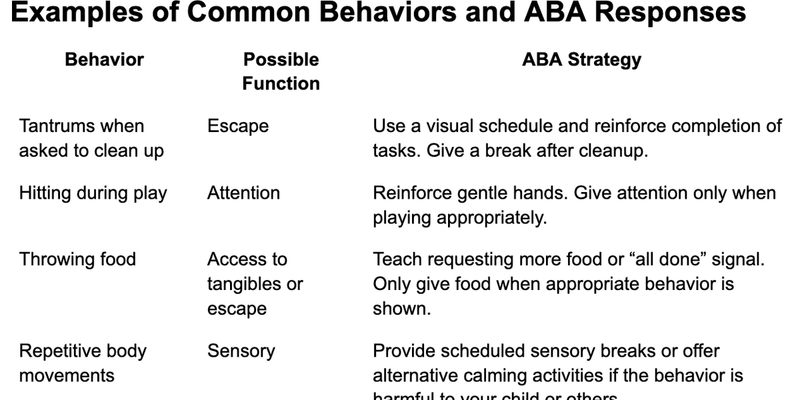Raising a child with autism can come with unique behavioral challenges. Applied Behavior Analysis (ABA) is a well-established, evidence-based approach that uses the science of learning and behavior to teach new skills and reduce behaviors that interfere with daily life. This guide will help you understand common behavioral challenges and how to respond effectively at home using ABA strategies.
Understanding Challenging Behavior
Challenging behavior often happens for a reason. In ABA, we look at the "function" of behavior—what your child is trying to communicate or achieve.
Common Functions of Behavior:
- Attention – Seeking interaction from others.
- Escape/Avoidance – Trying to get out of a task or situation.
- Access to Tangibles – Wanting a specific item or activity.
- Sensory/Automatic – Seeking or avoiding certain sensations.
Understanding why a behavior is happening is the first step to addressing it.
Step-by-Step ABA Strategies to Address Behavior at Home
1. Observe and Identify the Behavior
- Be specific. Instead of saying “he’s being difficult,” say “he throws his toys when asked to clean up.”
- Track when and where it happens to find patterns.
2. Determine the Function
- Ask yourself: What does my child gain or avoid by doing this?
- Use the ABCs:
- Antecedent – What happens right before the behavior?
- Behavior – What is the specific behavior?
- Consequence – What happens immediately after?
3. Modify the Environment
- Reduce triggers: If your child becomes overwhelmed by noise, create a quieter space.
- Give clear, simple instructions and use visual supports when possible.
- Offer choices to give your child a sense of control.
4. Teach Replacement Behaviors
- Teach what you want your child to do instead of the challenging behavior.
- Example: If your child screams to get your attention, teach them to tap your shoulder or use a word or sign.
5. Use Positive Reinforcement
- Reinforce desired behaviors by giving praise, tokens, or rewards.
- Be specific: “Great job using your words to ask for help!”
- Make sure the reinforcement is something your child values.
6. Respond Consistently
- Use consistent consequences. If a behavior is attention-seeking, avoid giving attention when it happens.
- Reinforce the replacement behavior every time it occurs.
Examples of Common Behaviors and ABA Responses

Tips for Success
- Be patient – Behavior change takes time.
- Be consistent – Everyone in the household should respond the same way.
- Celebrate small wins – Progress is progress, even if it's slow.
- Seek support – Connect with your child’s BCBA for guidance.
When to Reach Out for Help
If challenging behaviors persist, escalate, or pose safety concerns, reach out to a Board Certified Behavior Analyst (BCBA) or your child’s therapy team for individualized support and assessment.
With the right strategies, consistency, and support, you can help your child navigate challenging behaviors and build new, more functional skills. ABA empowers parents with practical tools to support their child’s growth in a positive, structured way.